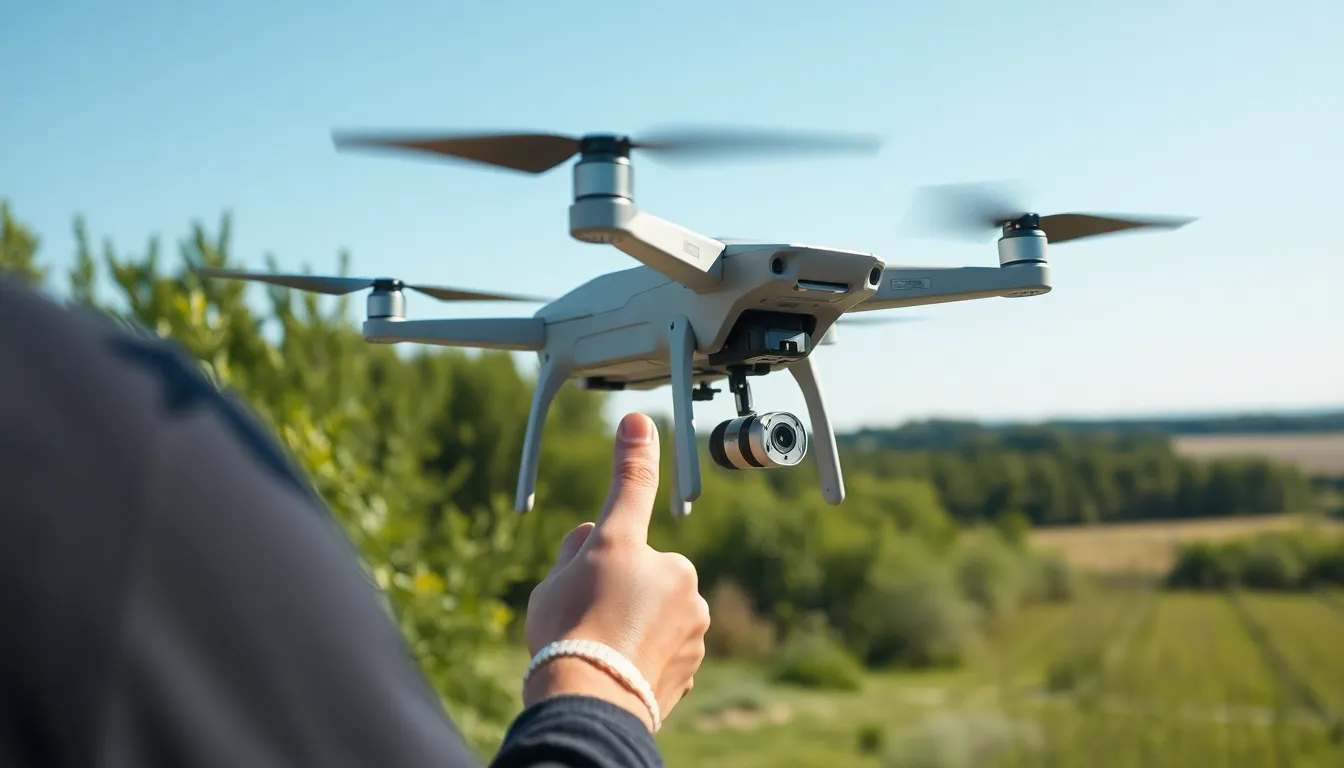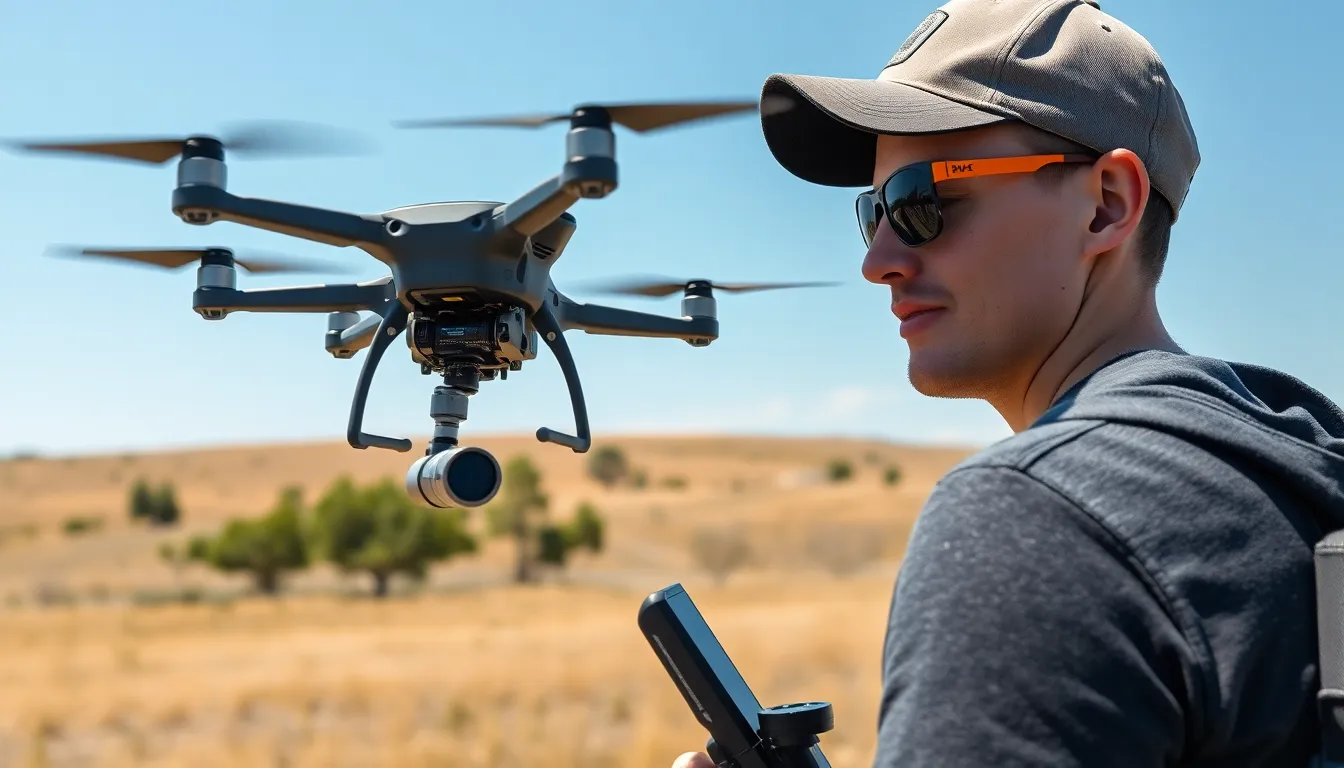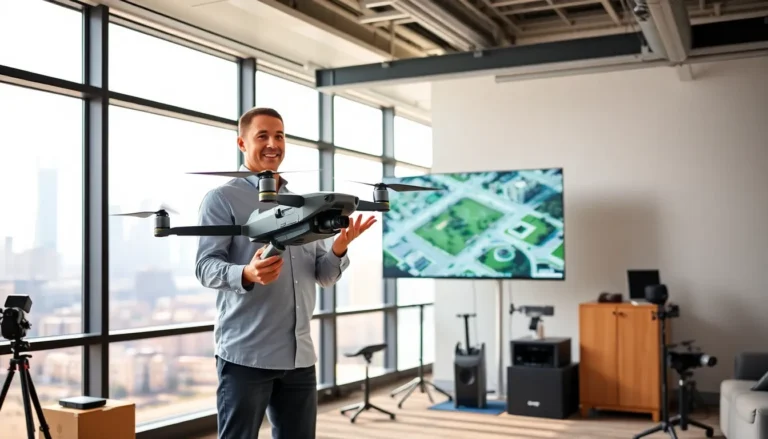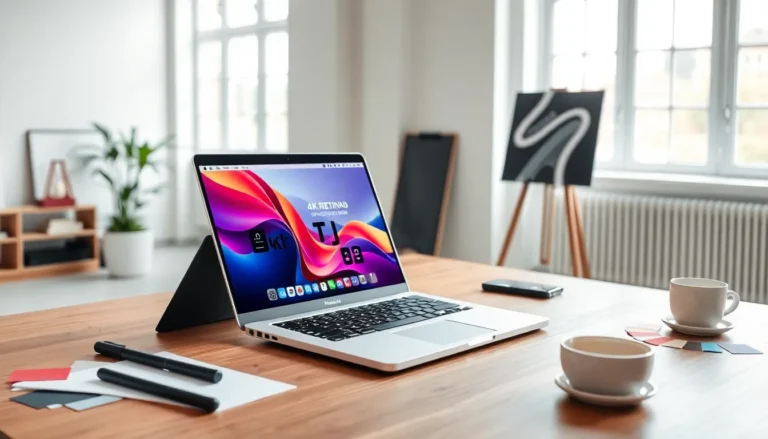Drones have taken the world of videography by storm, soaring high above traditional filming methods. Imagine capturing breathtaking aerial shots that make your viewers feel like they’re on a rollercoaster ride—without the long lines or nausea. With a drone in hand, filmmakers can transform ordinary scenes into cinematic masterpieces, all while giving their creativity wings to fly.
Table of Contents
ToggleOverview of Drones for Videography
Drones for videography have transformed the film industry by providing unparalleled accessibility to aerial shots. High-definition cameras mounted on drones enable filmmakers to capture breathtaking perspectives that were once difficult or impossible to achieve. Many filmmakers appreciate the versatility of drones, as they can adapt to various filming conditions and environments.
Different types of drones exist for videography, including quadcopters and hexacopters, each offering unique benefits. Quadcopters are popular for their stability and ease of use, making them ideal for beginners. Hexacopters, on the other hand, provide greater lifting capacity and better stability in windy conditions, suitable for professional-grade footage.
The technical specifications of drones also play a crucial role in videography. For example, a drone with a 4K camera provides crisp, high-quality visuals that enhance the final product. Battery life impacts flight duration, with some models offering flight times of up to 30 minutes or more, allowing for extended shooting sessions without frequent recharges.
User-friendly features add to the appeal of drones in videography. Intelligent flight modes, such as follow-me or waypoint navigation, simplify the shooting process and minimize the need for manual control. These advancements allow filmmakers to focus on creative aspects rather than technical details.
Regulations and safety measures are essential considerations when using drones for videography. Filmmakers must adhere to local laws, including maintaining line-of-sight and avoiding crowded areas. Additionally, understanding airspace restrictions ensures compliance and promotes safe flying practices.
Overall, drones have become essential tools in the filmmaker’s arsenal, enabling them to create visually stunning content while expanding their creative possibilities.
Types of Drones for Videography

Drones for videography come in various types, each suited for different applications and skill levels. Understanding the differences helps filmmakers choose the best option for their projects.
Consumer Drones
Consumer drones serve hobbyists and aspiring filmmakers. These affordable models often feature built-in cameras, making them accessible for capturing high-quality footage. Many include user-friendly controls and automatic flight modes that simplify operation, allowing users to focus on creativity rather than technicalities. Battery life usually ranges from 20 to 30 minutes, suitable for casual shooting. Models like the DJI Mini and Parrot Anafi exemplify popular choices, providing compact designs and impressive stabilization.
Professional Drones
Professional drones cater to seasoned videographers and filmmakers. These models boast advanced capabilities, including 4K or higher camera resolutions, ensuring stunning visual quality. Relying on robust flight systems, they manage complex maneuvers while maintaining stability in challenging conditions. Battery life often extends from 30 to 50 minutes, enabling longer filming sessions. Noteworthy options such as the DJI Inspire and the Freefly Alta stand out for delivering exceptional performance and versatility in various filming environments.
Key Features to Consider
When selecting a drone for videography, several features remain essential for optimal performance and quality.
Camera Quality
High camera quality becomes a priority for capturing stunning footage. Filmmakers often choose drones with 4K resolution capabilities. This resolution enhances details and clarity, making aerial shots captivating. Additionally, consider sensors that perform well in low light conditions. They improve image quality during dawn or dusk. The lens also plays a crucial role. Wide-angle lenses can capture expansive landscapes, while adjustable apertures can affect depth of field. Moreover, integrating gimbal stabilization ensures smoother shots, especially during movement.
Flight Time
Flight time significantly influences filming opportunities. Many consumer drones offer flight times ranging from 20 to 30 minutes on a single charge. Professional models extend this to 40 minutes or more, enabling prolonged shooting sessions. Frequent users must factor in battery charging times as well. Some drones feature quick-swap batteries, allowing for uninterrupted filming. Tracking power levels through an app can also provide valuable insights for planning shots effectively. Prioritizing longer flight times facilitates capturing essential footage without rushing.
Stabilization Technology
Stabilization technology enhances video quality, providing smooth footage. Drones equipped with three-axis gimbals ensure minimal shake during flight. This technology counters unwanted vibrations, delivering cinematic results. Advanced models may incorporate Electronic Image Stabilization (EIS), which further refines the footage during post-production. Understanding the benefits of each stabilization feature can guide selections based on production needs. Filmmakers benefit from drones that combine both physical and electronic stabilization for the best outcome. Continuous advancements in stabilization tech consistently improve the aerial filming experience.
Benefits of Using Drones for Videography
Drones provide unique perspectives that elevate videography. Aerial shots reveal aspects of landscapes and events often missed from ground level. Filmmakers gain access to high-quality visuals that enhance storytelling. Advanced camera systems capture intricate details, enriching the final product.
Cost-effectiveness stands out as a significant advantage. Traditional aerial filming methods, such as helicopters, incur high expenses. Drones, on the other hand, offer affordable alternatives without sacrificing quality. Notably, many consumer drones come equipped with built-in cameras that deliver exceptional footage.
Flexibility also characterizes drone use in videography. Filmmakers operate in various environments, from urban settings to natural landscapes. With intelligent flight modes, drones execute complex maneuvers easily. This adaptability caters to diverse shooting requirements, making them ideal for various projects.
Safety measures integrate seamlessly into drone technology. User-friendly controls simplify operation, ensuring that both beginners and seasoned professionals can film efficiently. Enhanced features, such as obstacle avoidance, contribute to safer flying practices while minimizing risks during filming.
Additionally, drones support creativity in videography. The ability to capture dynamic shots allows filmmakers to experiment with angles and movements. Unique perspectives provide creative storytelling opportunities, enabling the production of visually stunning films.
Regulatory compliance ensures safety and legality. Registered drones and adherence to specific guidelines foster a responsible filmmaking environment. Following these regulations empowers filmmakers to focus on creativity while ensuring public safety.
Overall, the benefits of using drones for videography include enhanced perspectives, cost savings, flexibility, safety, and creative opportunities. These advantages solidify drones as vital tools in the evolving landscape of visual storytelling.
Challenges and Limitations
Drones offer incredible advantages for videography, yet they come with challenges and limitations that filmmakers must navigate.
Regulatory Restrictions
Regulatory frameworks dictate drone usage, affecting where and how filmmakers can operate. Many regions require permits for commercial use, imposing restrictions on airspace and flight altitude. Compliance with the Federal Aviation Administration (FAA) regulations is essential to avoid penalties. Local laws may vary significantly, creating confusion for users. Notably, no-fly zones often exist around airports and populated areas, limiting accessibility. Awareness of these regulations promotes responsible drone operation and ensures public safety.
Technical Skills Required
Technical proficiency plays a crucial role in maximizing a drone’s potential for videography. Filmmakers must understand flight mechanics, camera settings, and drone controls to capture quality footage. Mastering manual mode often enhances creative control, allowing for unique shots. Knowledge of post-processing techniques also contributes to effective video editing. Furthermore, understanding battery management and maintenance ensures prolonged operation. As a result, aspiring drone videographers benefit from practice and training to elevate their skills.
Drones have undeniably transformed the landscape of videography. Their ability to capture breathtaking aerial views has opened up new avenues for creativity and storytelling. With a variety of options available for both consumer and professional use filmmakers can easily find a drone that fits their needs and budget.
As technology continues to advance filmmakers should stay informed about the latest features and regulations to maximize their drone’s potential. By embracing these innovations and adhering to safety guidelines filmmakers can create stunning visuals that resonate with audiences. Drones are not just tools but essential partners in the art of visual storytelling.





